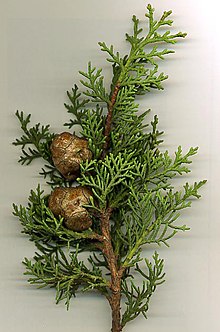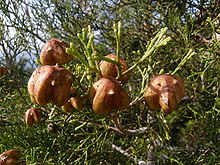Cupressaceae
| Cupressaceae Temporal range: (possible Late Triassic records)
| |
|---|---|

| |
| Cupressus sempervirens foliage and cones | |
| Scientific classification | |
| Kingdom: | Plantae |
| Clade: | Tracheophytes |
| Clade: | Gymnospermae |
| Division: | Pinophyta |
| Class: | Pinopsida |
| Order: | Cupressales
|
| Family: | Cupressaceae Bartlett[1] |
| Subfamilies[2] | |
| |
Cupressaceae is a
of mature trees is commonly orange- to red-brown and of stringy texture, often flaking or peeling in vertical strips, but smooth, scaly or hard and square-cracked in some species.Description

The

The
Cupressaceae is a widely distributed conifer family, with a near-global range in all continents except for Antarctica, stretching from 70°N in arctic
The world's largest (Sequoiadendron giganteum) and tallest (Sequoia sempervirens) trees belong to the Cupressaceae, as do six of the ten longest-lived tree species.
Classification



Molecular and morphological studies have expanded Cupressaceae to include the genera of
The family is divided into seven subfamilies, based on genetic and morphological analysis as follows:[10][11]
- Subfamily
- Cunninghamia R.Br.
- † Elatides Middle Jurassic- Early Cretaceous, Eurasia (possibly North America)
- † Hughmillerites Late Jurassic-Early Cretaceous Europe, North America
- † Sewardiodendron Middle Jurassic, Asia
- † Scitistrobus Middle Jurassic, Europe
- † Pentakonos Early Cretaceous, Asia
- † Acanthostrobus Late Cretaceous, North America
- † Mikasostrobus Late Cretaceous, Japan
- † Parataiwania Late Cretaceous, Japan
- † Ohanastrobus Late Cretaceous, Japan
- † Nishidastrobus Late Cretaceous, Japan
- † Cunninghamiostrobus Early Cretaceous-Oligocene Japan, North America
- Subfamily Taiwanioideae L.C.Li[12]
- Taiwania Hayata
- Subfamily Athrotaxidoideae L.C.Li[12]
- Athrotaxis D.Don – Tasmanian cedar
- Subfamily Sequoioideae Saxton[12]
- Metasequoia Hu & W.C.Cheng – dawn redwood
- Sequoia Endl. – coast redwood
- Sequoiadendron J.Buchholz – giant sequoia
- Subfamily Taxodioideae Endl. ex K.Koch[12]
- Cryptomeria D.Don – sugi
- Glyptostrobus Endl. – Chinese swamp cypress
- Taxodium Rich. – bald cypress
- Subfamily Callitroideae Saxton[14]
- Actinostrobus Miq. – cypress-pine
- Austrocedrus Florin & Boutelje
- Callitris Vent. – cypress-pine
- Diselma Hook.f.
- Fitzroya Hook.f. ex Lindl. – alerce
- Libocedrus Endl.
- NeocallitropsisFlorin
- Papuacedrus H.L.Li
- Pilgerodendron Florin
- Widdringtonia Endl.
- Subfamily Cupressoideae Rich. ex Sweet[15]
- Callitropsis Kurz – Nootka cypress
- Calocedrus Kurz – incense-cedar
- Chamaecyparis Spach – cypress
- Cupressus L. – cypress
- Fokienia A.Henry & H.H.Thomas – Fujian cypress
- Hesperocyparis Bartel & R. A. Price
- Juniperus L. – juniper
- MicrobiotaKom.
- Platycladus Spach – Chinese arborvitae
- Tetraclinis Mast.
- Thuja L. – thuja or arborvitae
- Thujopsis Siebold & Zucc. ex Endl. – hiba
- Xanthocyparis Farjon & T. H. Nguyên – cypress
A 2010 study of Actinostrobus and Callitris places the three species of Actinostrobus within an expanded Callitris based on analysis of 42 morphological and anatomical characters.[16]
Phylogeny based on 2000 study of morphological and molecular data.[17] Several further papers have suggested the segregation Cupressus species into four total genera.[18][19]
| Cupressaceae |
| |||||||||||||||||||||||||||||||||||||||||||||||||||||||||||||||||||||||||||||||||||||||||||||||||||||||||||||||||||||
A 2021 molecular study supported a very similar phylogeny but with some slight differences, along with the splitting of Cupressus (found to be paraphyletic):[6]
| Cupressaceae |
| ||||||||||||||||||||||||||||||||||||||||||||||||||||||||||||||||||||||||||||||||||||||||||||||||||||||||||||||||||
Uses
This section needs additional citations for verification. (December 2017) |

Many of the species are important
Several genera are important in horticulture.
Some species have significant cultural importance. The
The fleshy cones of Juniperus communis are used to flavour gin.
Native Americans and early European explorers used Thuja leaves as a cure for scurvy. Distillation of Fokienia roots produces an essential oil called pemou oil[37] used in medicine and cosmetics.[38]
Recent progress on Endophyte Biology in Cupressaceae, by the groups of Jalal Soltani (Bu-Ali Sina University) and Elizabeth Arnold (Arizona University) have revealed prevalent symbioses of endophytes and endofungal bacteria with family Cupressaceae. Furthermore, current and potential uses of Cupressaceous tree's endophytes in agroforestry and medicine is shown by both groups.
Chemistry
The Cupressaceae trees contain a wide range of extractives, especially terpenes and terpenoids,[39] both of which have strong and often pleasant odors.
The
Disease vectors
Several genera are an alternate host of Gymnosporangium rust, which damages apples and other related trees in the subfamily Maloideae.[41]
Allergenicity
The
References
- ^ a b c Watson, Frank D.; Eckenwalder, James E. (1993). "Cupressaceae". In Flora of North America Editorial Committee (ed.). Flora of North America North of Mexico (FNA). Vol. 2. New York and Oxford: Oxford University Press. Retrieved 6 September 2013 – via eFloras.org, Missouri Botanical Garden, St. Louis, MO & Harvard University Herbaria, Cambridge, MA.
- .
- hdl:11577/3400205.
- S2CID 90020476.
- hdl:1956/2482.
- ^ from the original on 10 January 2022. Retrieved 10 January 2022.
- from the original on 14 November 2023. Retrieved 15 February 2023.
- from the original on 15 February 2023. Retrieved 15 February 2023.
- S2CID 52120430.
- PMID 22550176.
- PMID 28120880.
- ^ a b c d e Armin Jagel, Veit Dörken: Morphology and morphogenesis of the seed cones of the Cupressaceae - part I. Cunninghamioideae, Athrotaxoideae, Taiwanioideae, Sequoioideae, Taxodioideae. In: Bulletin of the Cupressus Conservation Project, 3(3): 117-136 (PDF Archived 27 September 2016 at the Wayback Machine)
- S2CID 237705866.
- ^ Armin Jagel, Veit Dörken: Morphology and morphogenesis of the seed cones of the Cupressaceae - part III. Callitroideae. In: Bulletin of the Cupressus Conservation Project 4(3): 91-103 (PDF Archived 22 December 2015 at the Wayback Machine)
- ^ Armin Jagel, Veit Dörken: Morphology and morphogenesis of the seed cones of the Cupressaceae - part II. Cupressoideae. In: Bulletin of the Cupressus Conservation Project 4(2): 51-78 (PDF Archived 11 December 2015 at the Wayback Machine)
- doi:10.1071/sb09044.
- PMID 10898782.
- ISBN 1-84246-068-4..
- ^ Xiang, Q.; Li, J. (2005). "Derivation of Xanthocyparis and Juniperus from within Cupressus: Evidence from Sequences of nrDNA Internal Transcribed Spacer Region". Harvard Papers in Botany. 9 (2): 375–382.
- from the original on 31 October 2023. Retrieved 15 May 2023.
- ^ ISBN 978-962-7956-19-8.
- .
- ^ Fu, Liguo; Yu, Yong-fu; Adams, Robert P.; Farjon, Aljos. "Glyptostrobus". Flora of China. Vol. 4 – via eFloras.org, Missouri Botanical Garden, St. Louis, MO & Harvard University Herbaria, Cambridge, MA.
- ^ "Junipers". Chicago Botanic Garden. Archived from the original on 20 December 2022. Retrieved 19 December 2022.
- ^ Westerfield, Bob (6 October 2022) [15 May 2009]. "Junipers". University of Georgia Extension. Archived from the original on 20 December 2022. Retrieved 19 December 2022.
- ^ Satoh, Keiko (14 November 1998). "Metasequoia Travels the Globe". Arnoldia. Vol. 58, no. 4. Arnold Arboretum of Harvard University. pp. 72–75. Archived from the original on 14 December 2022. Retrieved 14 December 2022.
- ^ Cahill, Angela. "Nature's Masterpiece: Giant Sequoia". Pacific Horticulture. Archived from the original on 15 December 2022. Retrieved 14 December 2022.
- S2CID 233554030.
- ISBN 978-0-16-027145-8. Archived(PDF) from the original on 1 February 2023. Retrieved 15 December 2022.
- ^ Owen, Jeff (November 2011). "Selecting the Right Tree". North Carolina State Extension. Archived from the original on 15 December 2022. Retrieved 14 December 2022.
- ^ "El ahuehuete, Árbol Nacional" [The ahuehuete, National Tree] (in Spanish). National Forestry Commission. 25 September 2018. Archived from the original on 19 December 2022. Retrieved 18 December 2022.
- ^ Debreczy, Zsolt; Racz, Istvan (1997). "El Arbor del Tule: The Ancient Giant of Oaxaca" (PDF). Arnoldia. 57 (4). Arnold Arboretum of Harvard University: 3–11. Archived from the original (PDF) on 1 August 2010. Retrieved 19 December 2022.
- ^ "State Tree – California Redwood". California State Capitol Museum. 20 October 2021. Archived from the original on 19 December 2022. Retrieved 19 December 2022.
- ^ Thomas, Catherine Cullinane; Flyr, Matthew; Koontz, Lynne (June 2022). 2021 National Parks Visitor Spending Effects: Economic Contributions to Local Communities, States, and the Nation (PDF) (Report). Fort Collins, Colorado: U.S. National Park Service. pp. 36–37. Archived (PDF) from the original on 4 November 2022. Retrieved 19 December 2022.
- ISBN 978-1-5652-3271-6.
- ^ Reynolds, Christopher (19 May 2013). "Standing Before the Lone Cypress". Los Angeles Times. Archived from the original on 19 December 2022. Retrieved 19 December 2022.
- .
- doi:10.1002/ffj.1557.
- ^ S2CID 20371074.
- PMID 17979713.
- S2CID 7875028.
- S2CID 196440359.
- ^ Krihara (Kurihashi), M. (1997). "Physiochemical and immunological characterization of major allergens of Japanese cedar pollen and false cypress pollen". Allergology (in Japanese). 3: 203–211.
- ^ ISBN 978-1-60774-491-7.
Further reading
- Soltani, J. (2017) Endophytism in Cupressoideae (Coniferae): A Model in Endophyte Biology and Biotechnology. In: Maheshwari D. (eds) Endophytes: Biology and Biotechnology. pp. 127–143. Sustainable Development and Biodiversity, vol 15. Springer, Cham.
- Pakvaz, S, Soltani J. (2016) Endohyphal bacteria from fungal endophytes of the Mediterranean cypress (Cupressus sempervirens) exhibit in vitro bioactivity. Forest Pathology, 46: 569–581.
- Soltani, J., Zaheri Shoja, M., Hamzei, J., Hosseyni-Moghaddam, M.S., Pakvaz, S. (2016) Diversity and bioactivity of endophytic bacterial community of Cupressaceae. Forest Pathology, 46: 353–361.
- Farjon, A. (1998). World Checklist and Bibliography of Conifers. Royal Botanic Gardens, Kew. 300 p. ISBN 1-900347-54-7.
- Farjon, A.; Hiep, N. T.; Harder, D. K.; Loc, P. K.; Averyanov, L. (2002). "A new genus and species in the Cupressaceae (Coniferales) from northern Vietnam, Xanthocyparis vietnamensis". Novon. 12 (2): 179–189. JSTOR 3392953.
- Little, D. P., Schwarzbach, A. E., Adams, R. P. & Hsieh, Chang-Fu. (2004). The circumscription and phylogenetic relationships of Callitropsis and the newly described genus Xanthocyparis (Cupressaceae). American Journal of Botany 91 (11): 1872–1881. Available online Archived 15 May 2008 at the Wayback Machine.
External links
- Arboretum de Villardebelle Cone images of many species
- Gymnosperm Database: Cupressaceae
- Flora of China – Cupressaceae
- Flora of North America – Cupressaceae
- ×Taxodiomeria peizhongii tree named 'Dongfangshan’ US PP17767 P3
 Media related to Cupressaceae at Wikimedia Commons
Media related to Cupressaceae at Wikimedia Commons Data related to Cupressaceae at Wikispecies
Data related to Cupressaceae at Wikispecies
